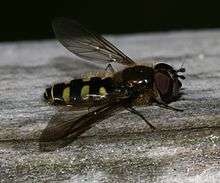Melangyna lasiophthalma
Melangyna lasiophthalma is a Holarctic species of hoverfly.[1][2]
| Melangyna lasiophthalma | |
|---|---|
 | |
| male | |
.jpg) | |
| female | |
| Scientific classification | |
| Kingdom: | |
| Phylum: | |
| Class: | |
| Order: | |
| Family: | |
| Genus: | |
| Species: | M. lasiophthalma |
| Binomial name | |
| Melangyna lasiophthalma (Zetterstedt, 1843) | |
Description
External images
For terms see Morphology of Diptera
Wing length 7-9·25 mm. Facial prominence projecting well beyond frontal prominence. Post-orbital strip wide. scutellar hairs mostly yellow towards anterior margin. Long hairs on general body surface black and brownish-yellow. The male terminalia are figured by Hippa (1968) ).[3] Larva described and figured by Goeldlin (1974) [4] and in colour by Rotheray (1994).[5]
See references for determination.
[6]
[7][8][9]
Distribution
Palearctic from Iceland and Fennoscandia South to the Pyrenees and mountains of Spain. Ireland East through North Europe and mountainous parts of Central Europe. East into European Russia and Siberia. Nearctic from Alaska south to Colorado and Maryland. [10][11]
Biology
Habitat: Quercus forest, Fraxinus and Salix gallery woods along rivers, Alnus, Salix, Betula forests, Abies and Picea forest, Atlantic scrub, hedgerows, suburban gardens, parks and orchards.[12] Flowers visited include Acer pseudoplatanus, Alnus glutinosa, Anemone nemorosa, Anthriscus, Caltha, Chrysosplenium oppositifolium, Corylus avellana, Euphorbia, Ilex, Lonicera xylosteum, Narcissus, Oxalis, Prunus laurocerasus, Prunus spinosa, Ranunculus, Salix, Sambucus, Sorbus aucuparia, Taraxacum, Tussilago, Ulex.[13] The flight period is March to June (later at higher altitudes and more northerly latitudes.
References
- Stubbs, Alan E. & Falk, Steven J. (1983). British Hoverflies: An Illustrated Identification Guide. British Entomological & Natural History Society. pp. 253, xvpp.
- Fauna Europaea
- Hippa, H. (1968) A generic revision of the genus Syrphus and allied genera (Diptera: Syrphidae) in the Palearctic region, with descriptions of the male genitalia. Acta Ent.Fenn., 25: 1-94.
- Goeldlin de Tiefenau, P. (1974) Contribution a l'etude systematique et ecologique des Syrphidae (Dipt.) de la Suisse occidentale. Bull.Soc.ent.Suisse, 47: 151 - 252.
- Rotheray G., 1993 Colour Guide to Hoverfly Larvae Diptera, Syrphidae in Britain and Europe Dipterists Forum pdf
- Van Veen, M. (2004) Hoverflies of Northwest Europe: identification keys to the Syrphidae. 256pp. KNNV Publishing, Utrecht.addendum
- Van der Goot,V.S. (1981) De zweefvliegen van Noordwest - Europa en Europees Rusland, in het bijzonder van de Benelux. KNNV, Uitgave no.32: 275pp. Amsterdam.
- Bei-Bienko, G.Y. & Steyskal, G.C. (1988) Keys to the Insects of the European Part of the USSR, Volume V: Diptera and Siphonaptera, Part I. Amerind Publishing Co., New Delhi. ISBN 81-205-0080-6.
- Coe, R.L. (1953) Diptera: Syrphidae. Handbks.ident.Br.insects, 10(1): 1-98. R.ent.Soc.London. pdf
- Fauna Europaea
- Peck, L.V. (1988) Syrphidae. In: Soos, A. & Papp, L. (eds.) Catalogue of Palaearctic Diptera, 8: 11-230. Akad.Kiado, Budapest.
- Speight, M.C.D. (2011). "Species accounts of European Syrphidae (Diptera)" (PDF). Syrph the Net, the database of European Syrphidae. 65: 285pp.
- de Buck, N. (1990) Bloembezoek en bestuivingsecologie van Zweefvliegen (Diptera, Syrphidae) in het bijzonder voor België. Doc.Trav. IRSNB, no.60, 1-167.